Wandering through the marble halls and lush gardens of Achilleion Palace in Corfu, I couldn’t help but feel swept into a world where imperial dreams and personal tragedy are tangled together. This stunning palace rises above the Ionian Sea, just 10 kilometers from Corfu town, built in 1890 by Empress Elisabeth of Austria—most know her as Sisi.
Achilleion isn’t just a monument to Greek mythology. It’s a window into the complicated inner life of one of Europe’s most fascinating royals.
My time at this remarkable estate peeled back layers I hadn’t expected. Sure, the palace dazzles with beauty, but it also reveals Sisi’s love for ancient Greece and her desperate need for peace after losing her son.
Every statue of Achilles, every column in those gardens, and each ornate room quietly tells the story of an empress who tried to find comfort in myth and splendor while wrestling with heartbreak.
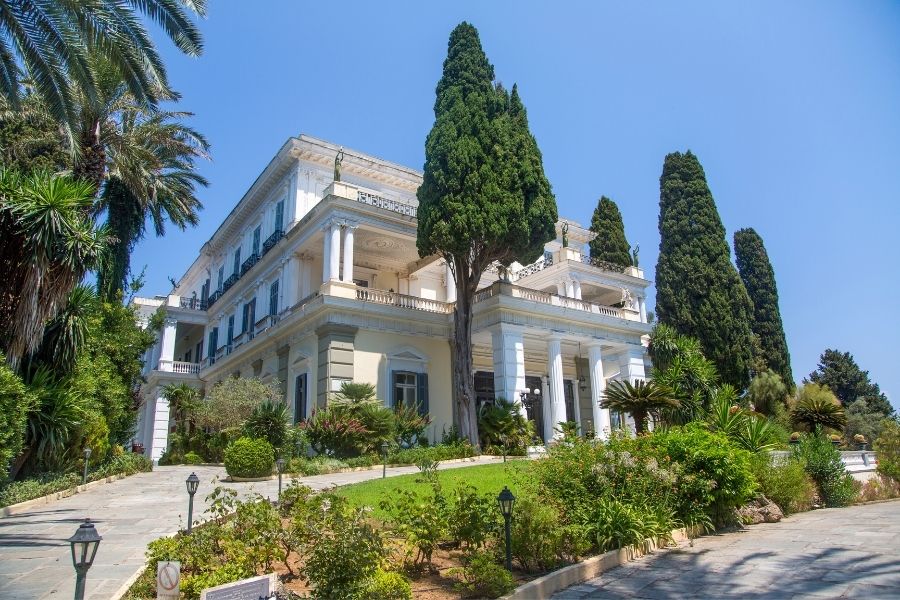
What really lingered with me? The way Achilleion captures both the showy grandeur of imperial Austria and the private wishes of a woman desperate to escape. The golden details in the throne room, those marble sculptures scattered through the gardens—Achilleion lets you see how architecture and art can express both public power and private pain.
Walking in Empress Sisi’s Footsteps: The Legacy of Empress Elisabeth
Empress Elisabeth of Austria’s legacy feels tangled and bittersweet. She lived through personal tragedies, fell in love with Greek culture, and met a shocking end that turned her into a legend.
Her connection to Corfu and passion for ancient mythology still draw people to the island.
Empress Elisabeth’s Life and Her Connection to Corfu
Elisabeth—Sisi—was born in Bavaria in 1837. She married Emperor Franz Joseph I of Austria in 1854 when she was only 16.
That marriage swept her into the strict Habsburg court, and honestly, it never quite suited her free-spirited nature. She often felt boxed in by royal duties and endless rules.
In the 1860s, Sisi discovered Corfu while traveling. The island became her escape from Vienna’s stifling atmosphere.
She fell hard for Corfu’s natural beauty and calm vibe. By 1889, she built Achilleion Palace as her private retreat.
Here, she could finally breathe. The palace reflected her passion for Greek culture and myth.
A few key facts about Sisi and Corfu:
- She first visited in the 1860s.
- Built Achilleion Palace in 1889.
- Spent winters on the island.
- Used it as a refuge from court life.
Personal Tragedy and the Roots of Sisi’s Sadness
Sisi’s life was shadowed by personal losses. Her eldest daughter Sophie died as a baby in 1857, a heartbreak that never really left her.
Then came the death of her only son, Crown Prince Rudolf, in 1889. He died by suicide at Mayerling, and that loss shattered Sisi.
Afterward, she wore only black and withdrew from public life. Grief consumed her, and she never quite recovered.
Friends saw her grow more isolated and sad. Sisi also wrestled with eating disorders and depression, becoming painfully thin and obsessed with exercise.
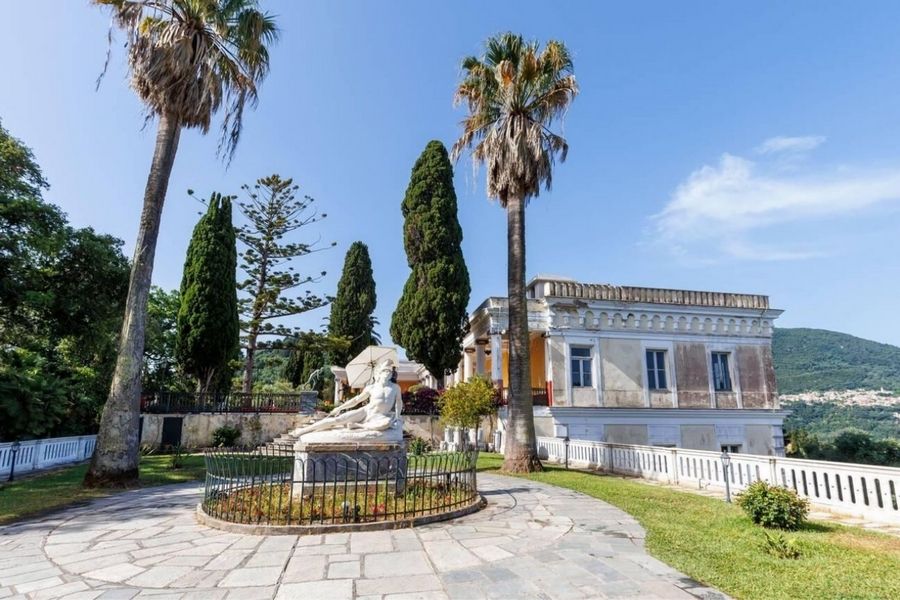
Court life only added to her struggles. These tragedies drove her to travel, searching for solace.
Corfu became her sanctuary, a place where she could process grief away from prying eyes. The island’s peace offered her a rare sense of relief.
Sisi’s Enduring Love for Ancient Greek Mythology
Sisi became obsessed with ancient Greek culture and mythology. She even learned to speak Greek fluently and devoured classical literature.
Homer’s Iliad was a favorite. Achilles, especially, became her hero.
She saw herself in his tragic story and noble character. His struggle between glory and doom resonated with her own life.
She named her palace after Achilles and filled it with statues and art depicting Greek gods and heroes. The gardens brim with mythological figures.
Sisi wrote poetry inspired by Greek themes, often comparing herself to mythic characters. Her poems reflected her admiration for ancient Greek ideals of beauty and honor.
Greek culture in her daily life:
- Learned Greek
- Studied Homer and classical texts
- Collected Greek art and sculpture
- Wrote poetry inspired by Greek myths
The Assassination and Her Lasting Influence
On September 10, 1898, an Italian anarchist named Luigi Lucheni assassinated Sisi in Geneva. He stabbed her with a file as she walked to board a ship.
She died at 60, still traveling as she had most of her adult life. News of her murder stunned Europe.
Her death turned her into a romantic legend—a tragic heroine who suffered for love and freedom.
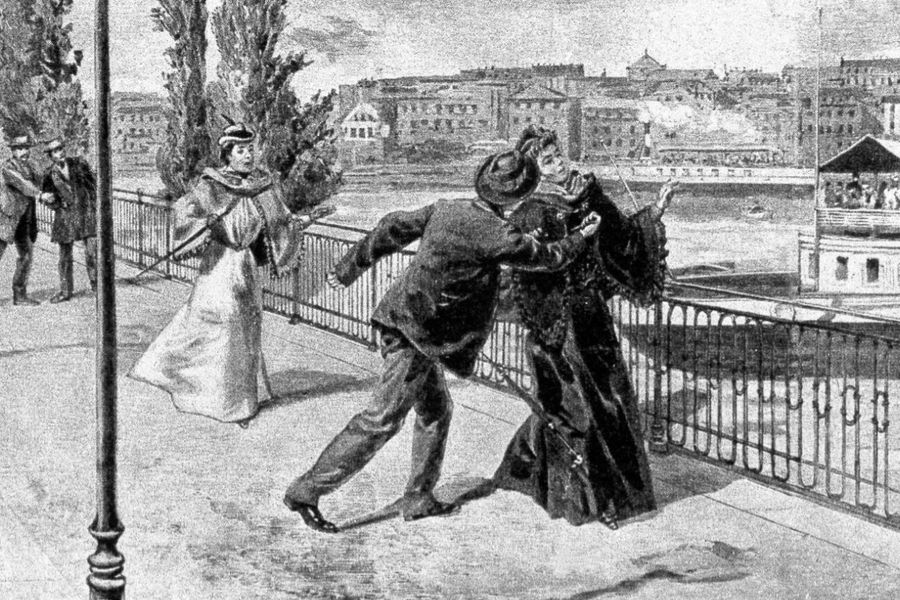
Sisi’s legacy lives on:
- Tourist sites across Europe
- Films and TV shows
- Countless biographies
- Monuments and statues
Achilleion Palace in Corfu stands as her most enduring monument. Visitors can wander the same rooms where she found peace and a connection to ancient Greece.
Achilleion Palace: A Testament to Imperial Splendor
Achilleion Palace stands out as one of Europe’s most striking examples of late 19th-century imperial architecture. It blends neoclassical design with Sisi’s deeply personal artistic vision.
Empress Elisabeth worked closely with Italian architect Raffaele Caritto. Together, they created a palace that fuses Austrian grandeur with Greek mythological themes—and even includes a Catholic chapel.
Origins and Vision Behind Achilleion
In 1888, Empress Elisabeth dreamed up Achilleion as her personal sanctuary on Corfu. She wanted a place to escape the rigid protocols of the Austrian court.
She named the palace for Achilles, her favorite Greek hero. Sisi saw herself in his tragic fate, especially after losing her son Rudolf in 1889.
She picked a hilltop spot in Gastouri village for its sweeping views of the Ionian Sea. The location offered privacy and natural beauty, exactly what she craved for healing.
Design principles she insisted on:
- Greek mythology at the heart of everything
- Neoclassical architecture echoing ancient Greece
- Gardens woven into the palace structure
- Panoramic positioning for those jaw-dropping views
Sisi personally involved herself in every design decision. She wanted Achilleion to pay tribute to Achilles and reflect her own complicated personality.
Architectural Masterpieces of Raffaele Caritto
Raffaele Caritto, an Italian architect, brought Sisi’s vision to life. His skill with neoclassical design made him the ideal choice.
He designed the palace with clean lines and balanced proportions. The facade boasts elegant columns and perfectly placed windows.
Caritto wove Greek architectural elements throughout. Ionic and Corinthian columns support terraces, and marble balustrades line the outdoor spaces.
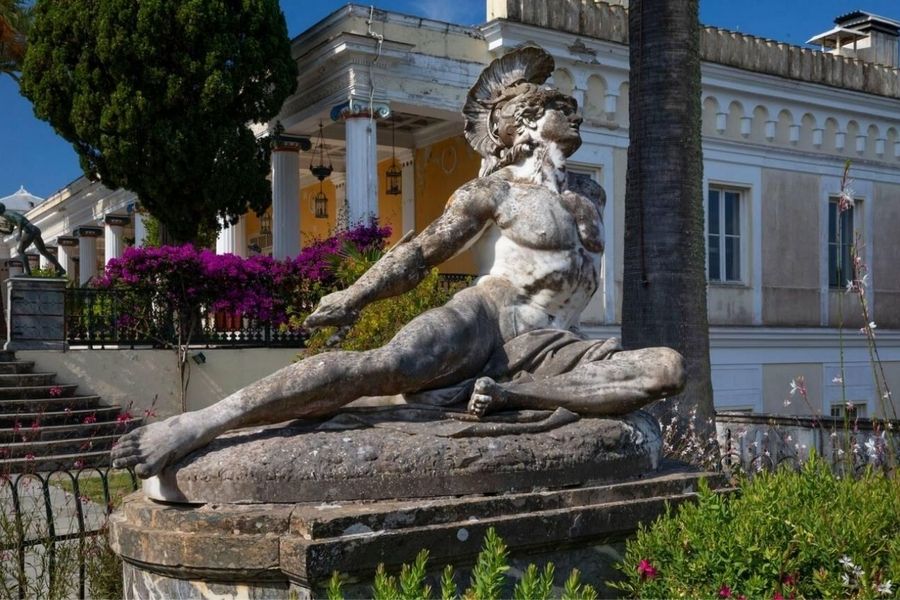
Some stand-out features:
- Peristyle of the Muses – a columned courtyard dotted with nine Muse statues
- Grand terraces – multiple levels with sea views
- Marble staircases – linking the palace’s different floors
- Classical proportions – all inspired by ancient Greek math
He integrated indoor and outdoor spaces in a way that just feels right for the Mediterranean. The palace flows naturally from room to garden terrace.
Opulent Interiors and Iconic Rooms
Inside, the palace mixes imperial Austrian taste with Greek flair. Each room reveals a bit of Elisabeth’s personal story through its décor.
The Throne Room steals the show. Gold and ivory details cover the ceremonial throne, and frescoes of Greek myths sweep across the walls and ceiling.
Notable spaces inside:
| Room | Key Features | Significance |
|---|---|---|
| Throne Room | Gold and ivory throne, mythological frescoes | Imperial ceremony space |
| Main Hall | Marble columns, painted ceilings | Reception area |
| Private Apartments | Personal furnishings, family portraits | Elisabeth’s living quarters |
| Dining Room | Austrian crystal, Greek pottery | Cultural blend display |
The palace museum now protects many original furnishings and personal items. I found Elisabeth’s writing desk especially moving, still sitting where she once wrote her poetry.
Artwork themed around Achilles fills the interior. Paintings and sculptures tell the Greek hero’s story, tying the rooms together with a single thread.
The Catholic Chapel’s Unique Presence
The Catholic chapel inside Achilleion always surprises people. It feels unexpected in a palace dedicated to Greek mythology and built on Orthodox soil.
Elisabeth included the chapel for her own spiritual needs as a Catholic empress. The elegant space allowed her to keep up her faith while living on Corfu.
The chapel’s design sticks to simple neoclassical lines, matching the rest of the palace. Caritto tucked it into the building’s structure without breaking the architectural flow.
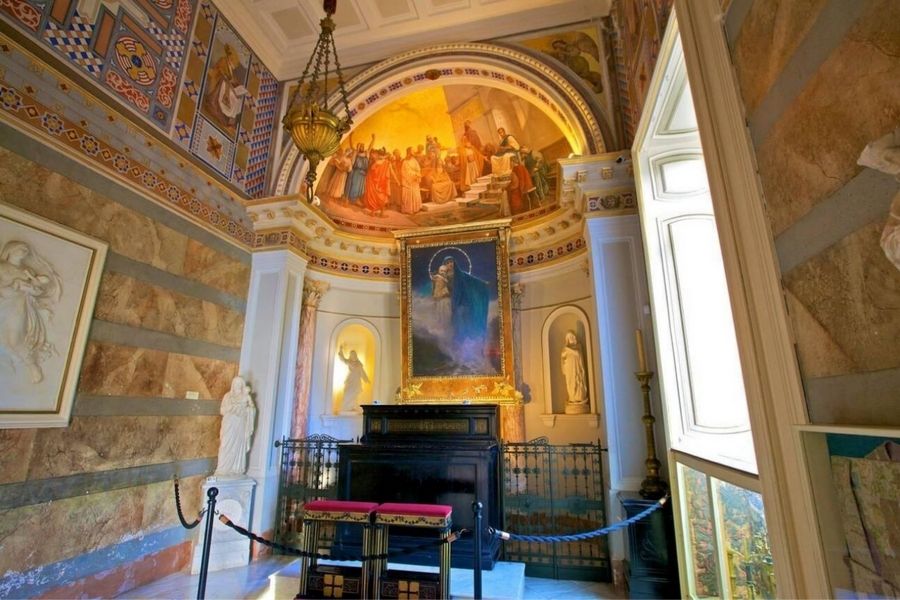
Chapel details:
- Intimate scale—meant for personal prayer
- Simple decor—no elaborate Catholic imagery
- Lots of natural light—big windows let the sun in
- Quality materials—marble altar, wooden pews
Both Elisabeth and Kaiser Wilhelm II, who bought the palace in 1907, used the chapel. Its practical importance outlasted its symbolism.
Today, the chapel remains consecrated and sometimes hosts small religious ceremonies. The quiet, peaceful vibe feels like a world away from the palace’s grander spaces.
Art, Myth, and Majesty in Achilleion’s Gardens
The palace gardens might be my favorite part. They’re packed with sculptures that blend Greek mythology with neoclassical art.
Every statue tells a story, turning the gardens into an open-air museum where mythological figures seem to come alive.
The Dying Achilles: Ernst Herter’s Masterpiece
The most powerful sculpture here has to be Ernst Herter’s Dying Achilles. This bronze masterpiece shows Achilles in his final moments, pulling an arrow from his heel.
I stood in front of it for ages. The detail in Achilles’ face holds both pain and dignity as he faces death.
Empress Sisi herself placed the statue in the lower gardens. She wanted visitors to see it first when they entered.
Quick facts:
- Material: Bronze
- Artist: Ernst Herter
- Date: 1884
- Location: Lower garden terrace
The craftsmanship is just stunning. Herter captured the hero’s muscular form and the acceptance in his expression—such a moving tribute to mortality.
The Triumph of Achilles and Other Sculptures
When Kaiser Wilhelm II bought the palace, he added his own mark. He commissioned Achilles Victorious, a massive statue showing Achilles as a triumphant warrior.
This statue stands in sharp contrast to Sisi’s dying hero. Wilhelm’s Achilles holds a shield and spear, all about victory instead of defeat.
The gardens feature other mythological figures too. I spotted statues of Hera, queen of the gods, scattered around the terraces.
Each sculpture highlights a different side of Greek mythology. Some show gods in their glory, others capture heroes in their struggles.

The mix of triumphant and tragic figures makes for an emotional journey. Wandering the gardens, you really feel like you’re walking through the full sweep of mythological storytelling.
Peristyle of the Muses: Homage to Legend
The palace terrace greets you with nine statues—each one a Muse from Greek mythology. They stand along the colonnade, each clutching a symbol tied to their art.
The Peristyle of the Muses feels like a sacred corner carved out for creativity. Every Muse watches over her own art, from poetry to astronomy.
The Nine Muses:
- Calliope (Epic Poetry)
- Clio (History)
- Erato (Love Poetry)
- Euterpe (Music)
- Melpomene (Tragedy)
- Polyhymnia (Sacred Poetry)
- Terpsichore (Dance)
- Thalia (Comedy)
- Urania (Astronomy)
Followers of renowned neoclassical sculptors probably crafted these statues. Their skill really shines through, echoing the traditions of Canova and Thorvaldsen.
As I wandered among the Muses, a strange sense of connection to centuries of artists washed over me. The way they’re positioned makes you feel like you’re walking alongside the very sources of creative inspiration.
Bronze Statues and Neoclassical Symbolism
The garden’s bronze statues capture the essence of 19th-century neoclassical art. Each figure channels classical Greek forms, yet somehow manages to express those big, romantic ideas about heroism and beauty.
Bronze gives these statues a certain timelessness. Over the years, the material weathers so gracefully, keeping those delicate details intact.
Sisi didn’t just pick any old themes—she chose ones that mirrored her own struggles. Dying heroes and suffering gods reflected her battles with loss and sadness.
There’s more to these statues than just decoration. The way each one sits in relation to the palace and the sea actually creates its own story.
The gardens act as an open-air gallery for mythological art. Walking those paths, I could sense how artists of the 19th century breathed new life into old Greek legends.
Gastouri and the Setting: Corfu’s Idyllic Landscape
Achilleion Palace sits in one of Corfu’s most beautiful spots, where rolling hills blend into village life. Getting there means weaving through ancient olive groves and mountain roads that show off Corfu’s wild side.
Journey Through Olive Groves and Ponti
I took the National Road out from Corfu Town, heading toward Achilleion. It’s the same road travelers have followed for more than a hundred years.
The road runs straight until you reach Ponti. There, a left turn marks the start of the real adventure.
After Ponti, the road begins to twist and climb. Suddenly, you’re surrounded by endless olive groves—these ancient trees cover the hills in a silvery-green blanket.
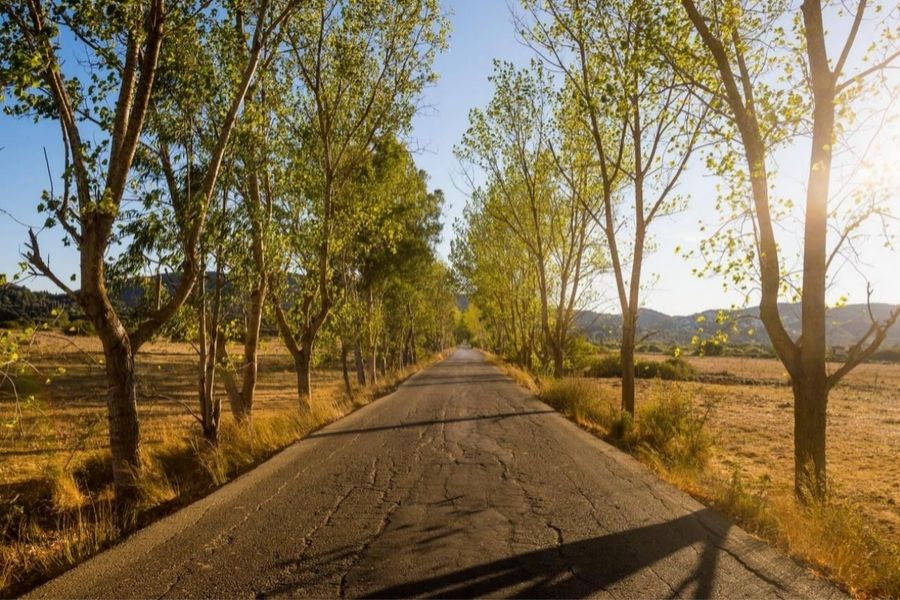
Every bend in the road offers a new glimpse of the sea. With each curve, the countryside shifts and surprises you.
It’s easy to see why Empress Sisi picked this spot for her summer escape.
The Village of Gastouri and Local Culture
Gastouri perches on a hilltop, about 10 kilometers southwest of Corfu Town. I found a small mountain village that still holds onto its traditional Greek roots, even with a palace next door.
The streets wind between houses with terracotta roofs. Local families tend gardens and olive trees that have stood here for generations.
Gastouri’s high vantage point gives you sweeping views across the island. It’s not hard to imagine why someone would come here searching for both beauty and solitude.
There’s a calm here that you just don’t get down by the busy coast.
Proximity to Agios Deka and Scenic Surroundings
The palace’s location makes it easy to explore southern Corfu. Agios Deka is close by, adding another layer of tradition and scenic lookouts to the area.
From Gastouri, you can see all the way across to Corfu city. The Mediterranean stretches out, blue and endless.
No wonder Sisi bought up land that reached right down to the sea.
The hills around the palace create a kind of natural amphitheater. It’s the perfect mix—mountain calm and coastal beauty, all wrapped around imperial grandeur.
Visitor Experience: Exploring Achilleion Palace Today
Visiting the palace today feels straightforward. There’s a clear entrance, helpful staff, and museum exhibits that cover all the highlights, plus plenty of support for international guests.
Practical Tips and Entrance Information
You’ll find the palace about 10 kilometers south of Corfu city, tucked in Gastouri. Just follow the National Road Corfu-Achillion.
The Imperial Gardens open daily from 08:00 to 20:00 during the busy season. I’d say go early, before the crowds and heat roll in.
Key visitor information:
- Location: Village of Gastouri
- Distance from Corfu Town: 10 km southwest
- Access: Winding road uphill through olive groves
- Parking: Available on-site
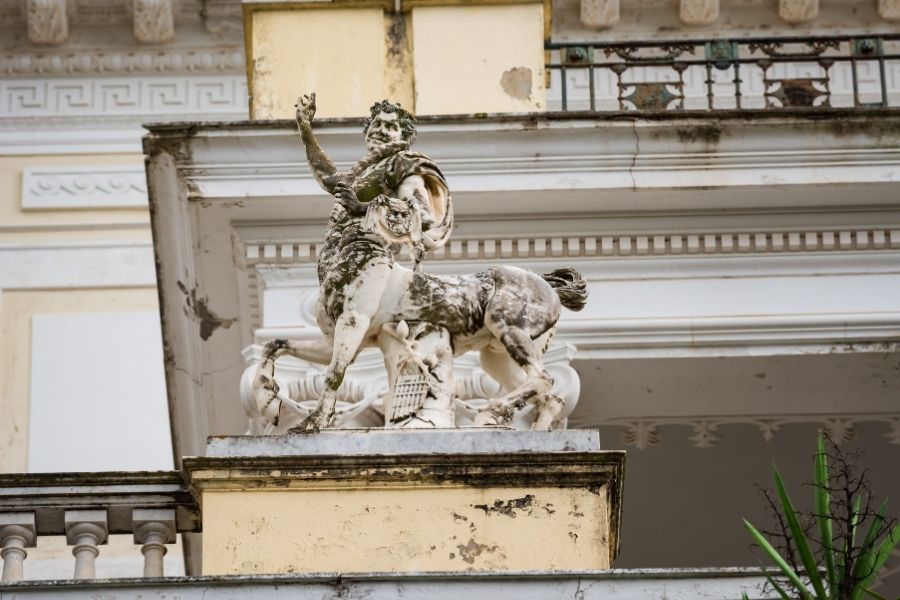
Give yourself 2-3 hours—enough time to wander through both the palace and the gardens.
Your ticket covers all the rooms and outdoor spaces. You can take photos in most areas, which is always a bonus.
Highlight Exhibits and Museum Guides
The Achilleion Museum holds remarkable collections of statues and paintings. I couldn’t help but linger at the Dying Achilles marble statue by Ernst Herter—something about the emotion in that piece just gets you.
Must-see exhibits:
- The Throne Room with its gold and ivory throne
- Peristyle of the Muses and their nine statues
- Achilles Triumphant by Ferdinand von Miller out in the gardens
- The Triumph of Achilles painting
The museum gives plenty of info about each piece. I found the stories behind the sculptors especially interesting.
In the gardens, sculptures and fountains pop up everywhere. Each one brings a different myth to life.
Language Accessibility and Available Tours
The palace makes it easy for international visitors. Info plaques come in Greek, English, and a handful of other languages.
Audio guides are available in several languages, offering in-depth stories about the palace’s history and Sisi’s life.
Tour options:
- Self-guided tours with audio equipment
- Group tours led by professional guides
- Half-day combo tours with local factory visits
Guides speak fluent English and really know their stuff about the palace’s architecture and royal history. If you’re visiting in summer, I’d book a guided tour ahead of time.
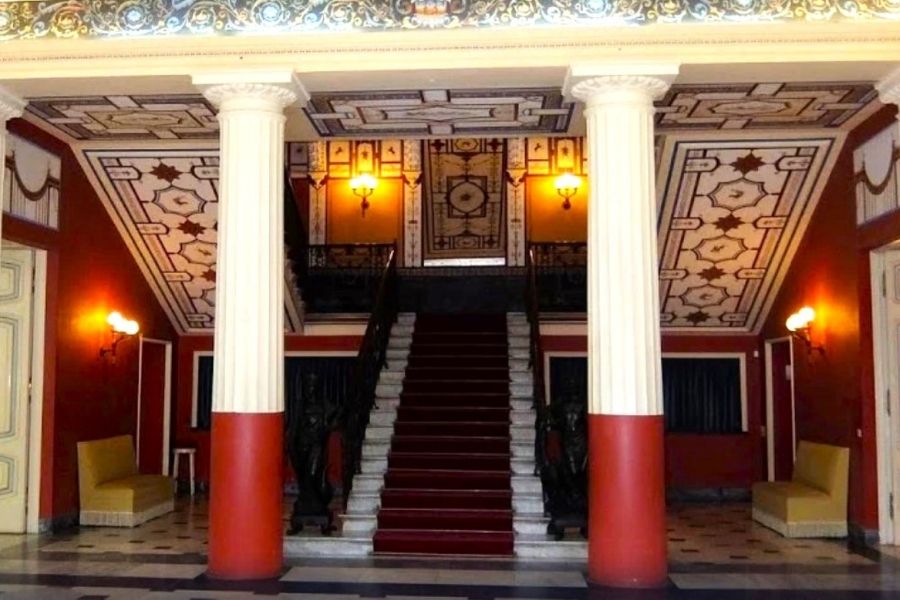
The staff at the entrance desk are happy to give you maps or advice in your language. They’re friendly and can point you toward the best exhibits.
Frequently Asked Questions
Achilleion Palace sparks a lot of questions—its history, Sisi’s story, and all the Greek mythology woven through the place. Here are the big ones visitors usually ask.
What is the historical significance of Achilleion Palace?
Achilleion Palace carries deep meaning as the sanctuary Empress Elisabeth of Austria built in 1890. She created it after losing her son, Crown Prince Rudolf, to suicide in 1889.
The palace became Sisi’s escape from court life and grief. Corfu’s beauty and ancient Greek culture fascinated her, so she made this her retreat.
She filled the palace with references to Achilles, the hero she felt drawn to. His tragic story became a theme that runs through the entire design.
After Sisi’s assassination in 1898, the palace changed owners and saw both world wars. Now, it stands as a museum that keeps this unique royal chapter alive.
Can visitors explore the interiors of Achilleion Palace, and what are the highlights?
Yes, you can walk through the palace interiors, now run as a museum by the Greek National Tourism Organization. The rooms still show off the original royal decor and furnishings.
The Throne Room is a real showstopper. There’s a gold and ivory throne that just radiates royal luxury.
The Peristyle of the Muses surrounds you with statues of the nine Muses. Each one represents an artistic inspiration woven into the palace’s design.
Inside, you’ll find paintings like “The Triumph of Achilles” and other art that reflects Sisi’s love for Greek culture. The museum also displays her personal items and artifacts from her time here.
What role did Empress Elisabeth of Austria play in the history of Achilleion Palace?
Empress Elisabeth—Sisi—imagined and created Achilleion Palace from the ground up. She hired Italian architect Raffaele Caritto to bring her dream to life in 1890.
Sisi picked out every detail herself, making sure the palace reflected her passion for Greek myths and culture. She chose the stories and themes that fill the art and architecture.
She used Achilleion as her personal refuge from the strict Austrian court. Here, she wrote poetry, studied Greek, and found some peace.
Her assassination in Geneva in 1898 ended her time at the palace, but her vision and story still shape everything about Achilleion.
How is Greek mythology represented in the architecture and decorations of Achilleion Palace?
Greek mythology is everywhere at Achilleion—statues, paintings, even the architecture. The palace’s name itself honors Achilles, Sisi’s favorite Greek hero.
In the gardens, you’ll spot two major Achilles statues with totally different vibes. “Dying Achilles” by Ernst Herter captures his tragic end, while “Achilles Triumphant” by Ferdinand von Miller shows him in full glory.
The Peristyle of the Muses brings the nine goddesses of arts and sciences to life in marble. Each one stands for a different creative spark—poetry, music, dance, and more.
Throughout the palace, you’ll notice Greek-style columns, marble work, and patterns that echo ancient temples. It’s a blend of Greek influence and neoclassical flair.
What are the entrance fees and visiting hours for Achilleion Palace?
I can’t give you the current entrance fees or hours—they change throughout the year. The Greek National Tourism Organization sets official prices and schedules.
Check the palace’s official website or ask at local tourism offices in Corfu for the latest info. Prices usually vary for adults, kids, students, and seniors.
The palace is typically open daily during tourist season, but winter hours may be shorter. Holidays and special events can also affect when you can visit.
It’s best to call ahead or check online before planning your trip. Sometimes there are group rates or combo tickets with other Corfu sights.
Are guided tours available at Achilleion Palace, and what topics do they cover?
Absolutely, you can join guided tours at Achilleion Palace if you’re after a richer, more personal look at its history. I’ve found these tours really bring the palace’s stories to life, especially if you’re curious about the art and architecture.
Tour guides usually dive right into Empress Sisi’s fascinating life and what led her to build this dreamy retreat. They’ll talk about her obsession with Greek culture and how it pops up in nearly every design detail.
If you’re into mythology, you’re in luck. Guides love to unravel the tales of Achilles, the Muses, and all those Greek legends woven into the palace and its gardens.
They don’t stop at ancient times, though. You’ll also hear how the palace changed after Sisi’s death, including its dramatic roles during both world wars.
And if you geek out over architecture or art, you’ll get plenty of insight into the building techniques and artistic styles scattered throughout. It’s honestly a great way to experience the palace—you catch so many details you’d probably miss on your own.

